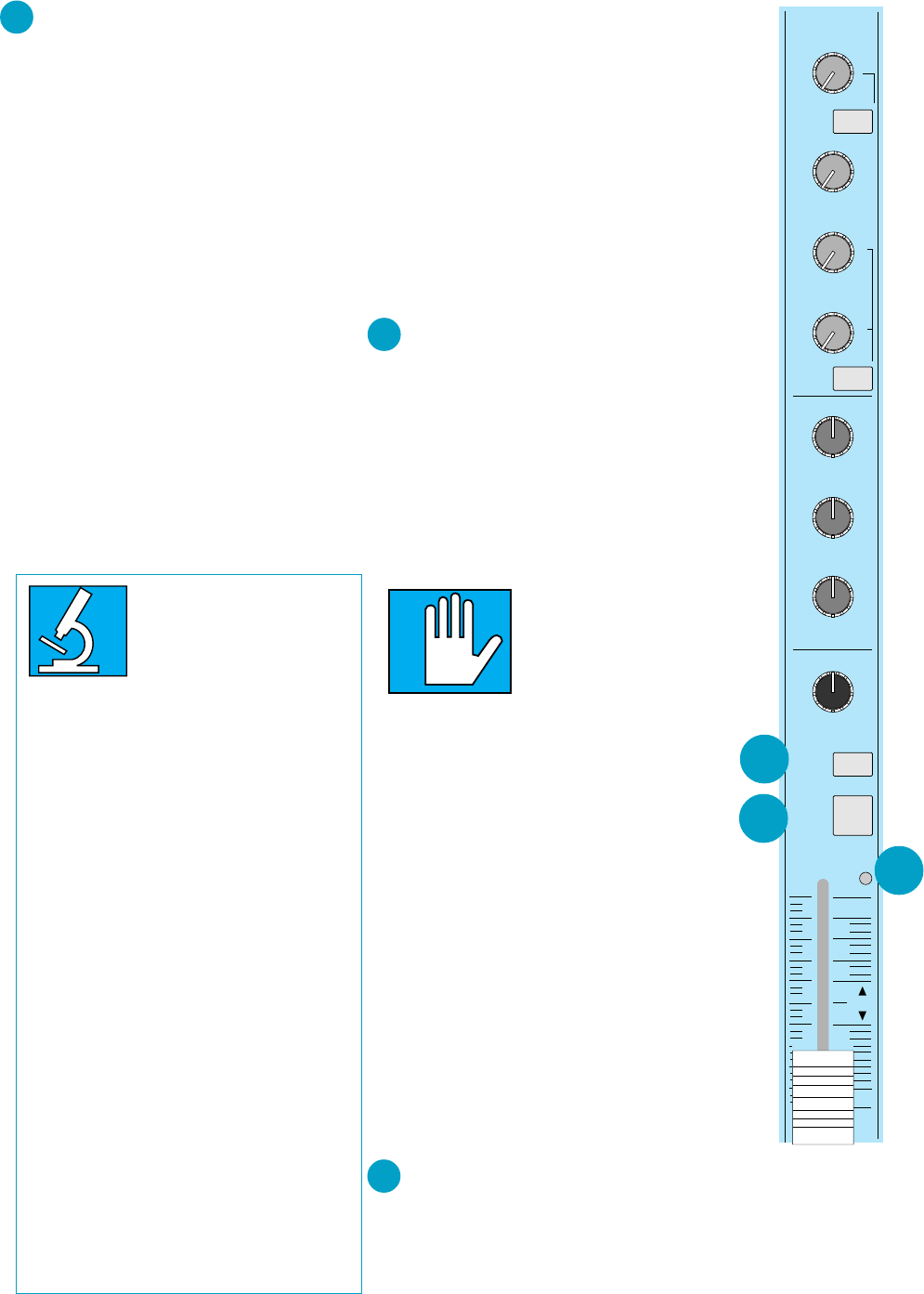
7
SOLO
This control does just what it’s name im-
plies. By pushing the SOLO button, you can
listen in on only that channel while muting
the rest of the mixer’s output.
In order to make this function really useful,
we have designed the CR-1604’s SOLO section
to allow for multiple inputs to be soloed
together while retaining the original stereo
placement of each channel in the mix. This
feature is not often found outside of large mix-
ing consoles, even though it adds significant
application potential to the solo function.
• The effect of this button follows the setting
of the SOLO TO MAIN button (i.e. if SOLO
TO MAIN is pressed IN, the main and
headphone outputs are replaced with the
soloed signals. If it’s left in the OUT
position, only the headphones will get the
soloed signals).
IMPORTANT: The master level of the SOLO
signal is controlled by the HEADPHONE/
SOLO fader, not the master faders.
• While a channel is in SOLO mode, its
signal level is sent to the CR-1604 Level
Meters in the Master Output section so
you can observe its working level. This
allows level setting for each individual
channel using just one meter pair.
• The SOLO indicator LED will also blink to
remind you that you are in the solo mode.
We designed it to be so obnoxiously bright
that you can get a suntan from it if you get
too close for too long. If you’ve ever used a
board with a tiny, obscure SOLO light, you
know why we made ours large and rude.
MUTE-ALT 3/4 (3rd & 4th buses)
Think of this as a “mute button PLUS.”
First, it works in the conventional way:
push MUTE and that channel goes away, just
like you’d expect. But, we reasoned, why send
the channel’s output into the ozone when it
could go someplace useful? Such as another
set of output buses.
So when you press MUTE, the signal is
reassigned to the ALT 3/LEFT and 4/RIGHT
stereo outputs.
NOTE: There is no mas-
ter level control for the
ALT-3/4 buses. With the
channel set at Unity, the
signal will come out at
Unity gain just as if you had a master fader at
the center detent position.
There are lot of possibilities via the ALT
3/4 buses with the channel fader set at Unity.
Especially combined with the ALT PREVIEW
button over in the CR-1604’s Master Output
section. For example, you can create two
stereo pairs for output to 4-track. Or bounce
multiple tracks onto one or two more tracks.
Or preview a sound source that hasn’t been
introduced into the mix yet.
One of the most common applications for
ALT 3/4 is for creating submixes from various
combinations of channels. By panning one set
of channels hard left and another hard right,
you can create two submixes (one from the
LEFT ALT and one from the RIGHT ALT out-
put) that can be routed back into spare
channels on the board, or AUX returns. (See
page 16 for more details.)
OL
The OverLoad LED is a visual indicator
that warns you when you’re overdriving the
channel. Because it monitors multiple points
in the channel’s circuitry, it detects more
than just input overload.
AUX
U
1
2
3
4
5
6
U
U
U
+1500
+1500
+1500
+1500
5/6
SHIFT
+15–15
0
HI
+15–15
0
MID
+12–12
0
LO
EQ
0
RL
PAN
SOLO
MUTE
ALT 3/4
OL
+20
U
00
1
MON
4
5
4
A CLOSER LOOK
WHAT CONSTANT POWER
PAN POTS MEAN TO YOU
When you sit between a pair
of monitors and pan from side to
side, the apparent loudness at
your ears should stay the same
no matter where the source is positioned.
The CR-1604’s constant power pan pots are so
named because they incorporate special circuitry
that maintains consistent acoustic power while
panning center to side.
When the input module is set to the center de-
tent, what you will hear is equal amounts of both
left and right outputs.
When the module is panned away from center,
you will begin to hear only one side. The side that
you are panning into must therefore grow louder to
make up for the loss of the other side. The effect is
a more realistic shift in dimensional perception
(Ooooo… sounds pretty cosmic, doesn’t it? )
Here is an example of how stereo sound be-
haves in real life, why you would want to duplicate
the same effect in your productions and how con-
stant power pan pots help:
Imagine that a sax player was standing in front
of you playing his horn. You get the same amount
of sound at both ears and your ear-brain process-
ing center sez, “This cat is right in front of me.”
Now the sax player moves to the left. More sound
arrives at your left ear and your brain sez , “He’s
over on the left.” But the total amount of sound ar-
riving at your ears is still the same.
Constant power pan pots do the same thing.
They move the sound, but don’t reduce the overall
amount of sound. Other small mixers don’t have
this feature. But like many other of the CR-1604’s
nifto-features, we wanted the mixer to perform to
the demanding standards of higher priced gear, so
that it could be used for professional recording,
broadcasting, and film sound where the need for
true panning integrity is often an unavoidable re-
ality. And low and behold, the CR-1604 IS being
used extensively by Hollywood pros for TV and
film sound tracks. End of commercial.
5
VERY IMPORTANT
6
6
